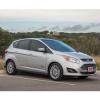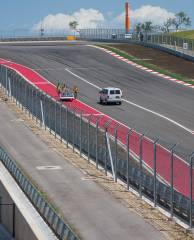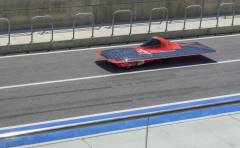-
Posts
85 -
Joined
-
Last visited
Content Type
Profiles
Forums
Gallery
Everything posted by viajero
-

Ford to lower fuel economy rating on C-Max hybrid
viajero replied to slampro's topic in Articles, News & Reviews
You've got it backwards. Testing at a single speed would be impossible to game, especially for a long run. Accelerating and decelerating are where the hybrid programming can be tweaked to match the test profile. Also, for the highway case, a single speed IS real world conditions. If you're not driving at a constant speed for a long time, I'd call that "city" or "combined", not highway. -
Nice! Was that up by Cloudcroft? Sounds very similar to my recent trip to Montana and back. Just over 37 mpg overall (though I did mooch a couple charges of the Energi from relatives). Low 30s on Texas freeways, high 30s on Colorado freeways, low 40s driving in the mountains, and an all time low of 27 mpg on that 20-mile stretch of rough pavement west of Dumas. The C-Max does have good ground clearance, for a compact car anyway. Looking at the underside, the plating looks pretty flimsy, though. I think they're more for aerodynamics than protection from rocks!
-
It's probably not too difficult to construct a mathematical model of the energy loss/storage while decelarating to a stop, but the trick is finding the constants to plug in to the equations. And some of those "constants", such as regen efficiency are probably functions of speed, state of charge, etc. If you really want a precise answer, it might be easier to measure the end result by taking an Energi out and doing repeated test runs each way, and seeing how many kWh you used. But I don't want a precise answer badly enough to do that. I'll just not drive like a maniac and call it good.
-
That was my point. A cold engine starting at 50 mph is no different than a cold engine starting at 0 mph because the second motor generator allows the computer to start the ICE and warm it up at whatever rpm it wants, regardless of what speed the wheels are turning.
-

Ford to lower fuel economy rating on C-Max hybrid
viajero replied to slampro's topic in Articles, News & Reviews
It's a good thing the speed limit map matches the population density map because it's safer to drive at higher speeds with fewer other cars around. In Texas once you're outside a city or town, almost all paved roads are 70 mph. Interstates are 75. From where I live I'd have to drive the better part of a day to get to where rural speed limits are less than 70 (OK maybe a short day to the south or east but a long day going north or west). The EPA already has 3 numbers - city, highway, and combined. I still think "highway" should be just that, open road at high speed. A 55 mph road on the east coast with lots of traffic is what I'd call "combined". "City" to me means surface streets with stoplights. Of course that's my own opinion; those words aren't so precisely defined... -

Ford to lower fuel economy rating on C-Max hybrid
viajero replied to slampro's topic in Articles, News & Reviews
There was some discussion on this on the Energi forum a while back. Highway speed limits in the western half of the U.S. are usually 70 or 75 mph, and in those 75 mph states there are lots of open roads where you can actually set the cruise control at 75 and drive for hours, no law breaking required. I think the EPA should test the fuel consumption at a constant 75 mph and call that the highway mileage. http://en.wikipedia.org/wiki/Speed_limits_in_the_United_States -
Starting the ICE at high speeds is normal - it turns on and off smoothly while going up and down hills at 70+ mph on the highway all the time. The MG1 spins as necessary to start the ICE for whatever speed the MG2 and the wheels are turning.
-
Someone on this forum reported that the ICE spins for engine braking on a downgrade once the battery is full, but I don't remember where it was. I don't think the friction brakes will ever grab in any mode unless you press the brake pedal. But, you can press the brake pedal to some unknown threshold and only get regen (no friction brakes).
-
I like the way dark colors look. My first new car in Austin was a black Cherokee. Since then I've stuck to lighter colors but it was certainly tolerable. Just get your windows tinted and a sunshade for your windshield. The glass roof is tinted from the factory but I had them put the film tint on that as well. It still lets in plenty of light, IMO.
-
Here in Austin I saw some ICE cars parked in "electric vehicle only" parking slots at a city park. There was a cop there responding to some other people's complaint about double-parked cars, so I asked him about the EV spaces. He said there's no city ordinance backing up that sign, so he couldn't do anything about it. It's totally on the honor system. That said, around here I've found that one particular park is the only place non-EVs frequently park in the EV spaces, even when there are empty spaces nearby. In most other lots people respect the EV signs even when the lot is quite full. Of course a private property owner can have cars towed if they disobey signs in their parking lot, but I doubt many retailers would want to cause conflict with a customer by doing so. I suspect the sort of person who would park an ICE car in an EV space would be a bigger pain about being towed than you would about having someone else in your space.
-
I'm a big Wheelskins fan as well, even though they're a pain to install, I think they're worth it. The tumors seem to be the fashion these days. My previous two cars (Honda and Mazda) both had them. I can't quite close the gap in the Wheelskin but no biggie.
-
You guys have got me thinking about coasting a bit. It seems there are two cases - coming to a complete stop and pulse/gliding. When gliding, you definitely don't want to regen due to the aforementioned inefficiences. You want to keep your kinetic energy as long as possible with the engine cut off, rather than converting kinetic energy into battery energy and back to kinetic energy again. Various hypermilers say they've verified this by experiment, but I don't pulse and glide myself. When coming to a complete stop, all your kinetic energy has to be converted into some other form of energy. When purely coasting to a stop, 100% of the kinetic energy converts to heat, through friction in the tires, drivetrain, and through air resistance. When coming to a complete stop from the same speed using regen, some nonzero percentage of that kinetic energy becomes useful battery charge, which can be used to save fuel when you next accelerate. So at first glance it would seem stopping with regen is more efficient, at least in terms of what percentage of kinetic energy is recovered. But, since your stop would be more abrupt using regen than purely coasting, you would have been traveling at full speed for more time, thus losing more energy to air resistance before you started slowing down. Which one uses more energy to get from point A to point B? Hard to theorize without more data. It may vary depending on how fast your initial speed is. I'm not sure. Maybe someone with more time and motivation than I have can do some experiments...
-
I don't think this is strictly true. Based on various documents on Prius forums, the motor/generators are still geared to the wheels and still spin when in what the shifter calls "neutral". The motor/generators are electrically disconnected, so they offer no extra torque or drag. I'm being kind of pedantic here as the end result is essentially the same. Theoretically, you could achieve the same thing when in "drive" gear by feathering the gas pedal just right so that the battery was neither charging nor discharging. In practice it would be hard to achieve that perfect balance, and I wouldn't want to pay that much attention, anyway. The counterintuitive thing about a power split hybrid is that nothing mechanical ever happens when you change between N, D, L, and even R. All the gears are still connected exactly the same in all four cases. The gearshift just tells the computer how to feed electrical energy in or out of the two motor/generators. Even when you select reverse, the motor is still geared to the wheels the same as in drive. The computer just changes the phasing of the AC power and causes the big motor/generator to turn backwards.
-
I can't say with absolute certainty for the hybrid, but this brochure for the Energi indicates the inverter is liquid cooled. It may go to the radiator you're blocking. http://www.google.com/url?sa=t&rct=j&q=&esrc=s&source=web&cd=1&cad=rja&ved=0CCwQFjAA&url=http%3A%2F%2Fmedia.ford.com%2Fimages%2F10031%2F2013_CMAXHybrid_Hero.pdf&ei=NAnSUcnEH4-a8wT47oDAAg&usg=AFQjCNGQ8r6l9S9aPX-lHjeG1KMl0xzSag&bvm=bv.48572450,d.eWU On the Energi forum someone posted X-Gauge codes for things like inverter temperature and motor temperature, but they did not work for me. (I did get battery temperature, state of charge, and interior temperature to work, though). http://fordcmaxenergiforum.com/topic/1293-scangauge-x-gauges-programming-c-max-ffh/ Even if you can't read the temperature, I would hope the car's computer monitors it and would throw a warning light or start cutting power before damaging itself, but it is something to think about in hot weather.
-
I drove that 80 mph toll road to COTA on Saturday. I have a Scangauge and the instantaneous mpg was around 30. That will certainly knock down your average.
-

Suitability for occasional towing
viajero replied to mikeash's topic in Cargo, Hauling, Roof Racks & Towing
There's no wiring harness on the C-Max, so if your trailer has lights or brakes they won't work. -
It would probably work well for running a fan, but probably never for a car. The total amount of solar energy hitting a car on the brightest days is only a few kW, less than 10 horsepower. On cloudy days or when the sun is low in the sky it's less than that. So even if someone invents 100% efficient solar panels, they won't move a very big car. Yesterday I watched some of the Formula Sun race in Austin. College teams built and raced solar cars. Some were pretty impressive, but extremely lightweight and streamlined. They all were crawling by the time they got to the top of the big hill, and one didn't make it up at all.
-
From the album: Viajero
Most cars barely made it up this big hill. This one didn't quite do it and they had to send the SAG wagon. -
From the album: Viajero
College teams built and raced solar-powered cars at Circuit of the Americas. -

2013 Ford C-Max vs. 2013 Toyota Prius v Comparison Test
viajero replied to HannahWCU's topic in Articles, News & Reviews
When my grade-school-age nephew first saw the C-Max he said "It's a minivan!". To me a minivan has to have sliding doors but somehow it makes that impression on people. -
I feel it's worth pointing out here that almost no car makes financial sense. Somewhere out there is a car with the lowest total cost of ownership over whatever number of years you care about. Most likely a Hyundai or Kia of some sort. Late model used cars may be better. Any other car doesn't make financial sense. A car is not an investment.* It's a consumable item, like food or gasoline. All the money spent on the purchase price will eventually be depreciated away. And of course money for gas, insurance, and maintenance disappears immediately. I ask myself - for the money I'm spending, is it worth what I'm getting? Is the speed, capacity, comfort, quietness, safety, looks, off-road ability, environmental impact, or whatever I care about worth the money I'm forever losing to depreciation, fuel, and so on? * Of course, there are some collectible cars which appreciate in value over time. C-Max is not likely to be one of them.
-
Like any financial analysis over many years, there's a lot of guesswork in predicting what prices, rates, and tariffs are going to do in the future. I sized my solar panels per the utility's net metering scheme, which allowed you to offset your home consumption, but paid a very low rate for any extra generation. Then, a year later, my A/C died and I replaced it with a new one which uses much less energy, so I was generating extra. The, a year after that, they ditched the net metering scheme and now just charge you for all the energy your house uses, and pay you a fixed rate for all the energy your solar generates. That tariff is generous enough to give me big credits on my electric bill in all but the hottest three months of the year, even after charging my Energi. The solar tariff is reviewed every year, so of course, it could be cut back...
-
If you're checking the voltage that often it might be worth getting one of the little voltmeters that plug in to the cigarette lighter. http://www.amazon.com/s/ref=nb_sb_noss_2/190-2423816-1183555?url=search-alias%3Daps&field-keywords=car%20volt%20meter I wouldn't spend the money on a Scangauge just for this function but if you were thinking of getting one it can show the battery voltage.




